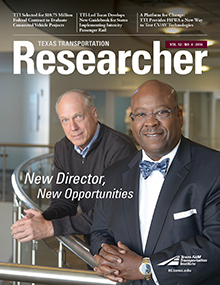Can an automated, commercial two-truck platoon be deployed on specific corridors in Texas in the next five to ten years? Thanks to a successful test by the Texas A&M Transportation Institute (TTI), the Federal Highway Administration (FHWA) and the Texas Department of Transportation (TxDOT), the agencies are one big step closer to answering that question.

TTI hosted a first-of-its-kind two-truck platooning technology demonstration at The Texas A&M University System RELLIS Campus on July 22, 2016, highlighting one of the TxDOT Innovative Projects. TTI System Reliability Division Head Beverly Kuhn and a team of 15 researchers and in-kind private partners collaborated on the successful test. Representatives from TxDOT, FHWA, the A&M System, TTI leadership and Ricardo Rail, a private-sector partner, viewed the test. Besides Ricardo, the other private-sector partners involved in the project are Navistar, TRW, Denso, Bendix, GreatDane Trailer and Lytx. In addition, Argonne National Laboratory and the U.S. Army Tank Automotive Research, Development and Engineering Center are also participating.
The system successfully executed all platooning scenarios planned for the demonstration. Two Navistar 18-wheelers first linked up and traveled in a figure eight at about 40 mph, followed by an increased gap distance, and ended with left and right lane changes in both directions.
“I’m not surprised at all that this type of innovation is happening in Texas,” says Al Alonzi, administrator of FHWA’s Texas Division. “These kinds of partnerships — between TxDOT, TTI, USDOT [U.S. Department of Transportation], and private-sector contributors — are the glue to innovation where the rubber is really going to meet the road, and that’s what makes me most proud. I have no doubt that the best is yet to come.”
Platooning fits neatly into TxDOT’s long-term vision for freight. “Freight improves the quality of life for citizens and businesses,” says TxDOT Transportation Engineer Marco Cameron. “And commercial truck platooning provides a way for freight to be delivered in a more efficient and cost-effective way.”

The demonstration project’s unique features include combining lateral and longitudinal control to provide automated steering, acceleration and braking without the driver in the loop. When the system is engaged, the two trucks travel together as one, while maintaining a consistent driver-adjustable separation distance.
Each truck is equipped with radar, cameras, sensors, vehicle-to-vehicle communications and a driver-monitoring system. The combination of these technologies, along with control algorithms, allows the trailing vehicle to safely and closely follow the lead truck. The lead driver operates the truck manually. The second driver is present in the following truck and can take over control if necessary but isn’t required to steer or control speed. The system keeps the trucks perfectly aligned.
“The benefits to this type of system are numerous,” says Kuhn. “With safety as the primary driver for this technology, the average projected fuel savings is up to 12 percent, and highway throughput will be notably better as well.”
TTI Research Scientists Mike Lukuc and Mohammad Poorsartep co-led this concept feasibility phase.
According to Lukuc, “Now that we’ve demonstrated that the platooning concept works, our phase-two focus will include fine-tuning the vehicle system, adding to the capabilities and robustness of this platform, and continuing the policy and concept-of-operations work that was done in the earlier foundational studies.”
The ultimate goal in future phases of this research is to operate these vehicles on the road. The project identified candidate locations where two-truck platoons would provide benefits to the operators and a safe environment for other road users.



